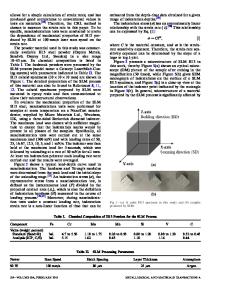Microstructural Characterization and Mechanical Performance of Hot Work Tool Steel Processed by Selective Laser Melting
- PDF / 774,327 Bytes
- 5 Pages / 593.972 x 792 pts Page_size
- 83 Downloads / 387 Views
he interrelationship between processing parameters during additive layer manufacturing employing selective laser melting (SLM) and the microstructural evolution in H13 hot work tool steel was investigated in this study. A thorough set of experiments was carried out comprising SLM processing of differently oriented specimens, tensile testing, and microstructural characterization based on Xray diffraction (XRD) and transmission electron microscopy (TEM). After the SLM processing of the generally ferritic/martensitic H13 tool steel, retained austenite was found within the microstructure at room temperature. During the tensile tests, retained austenite in part transforms to martensite yielding a distinct hardening behavior in the H13 specimens. The current findings constitute a step forward toward better understanding, controlling, and improving the microstructure evolution during SLM processing of ferritic/martensitic steels.
MARTIN JOACHIM HOLZWEISSIG, Group Leader, and MIRKO SCHAPER, Professor, are with the Lehrstuhl fu¨r Werkstoffkunde (Materials Science), University of Paderborn, 33095 Paderborn, Germany. Contact mail: [email protected] ALEXANDER TAUBE and FLORIAN BRENNE, Research Assistants, are with the Lehrstuhl fu¨r Werkstoffkunde (Materials Science), University of Paderborn, also with the Direct Manufacturing Research Center (DMRC), 33098 Paderborn, Germany. THOMAS NIENDORF, Emmy-Noether Group Leader, is with the Institute of Materials Engineering, Technische Universita¨t Bergakademie Freiberg, 09599 Freiberg, Germany. Manuscript submitted November 20, 2014. METALLURGICAL AND MATERIALS TRANSACTIONS B
Lately, additive manufacturing and additive layer manufacturing, respectively, are gaining increasing interest from industry as well as academia.[1–4] Originally, these techniques were developed from rapid prototyping processes and are now adaptable for the cost efficient production of small to medium batches of components exhibiting a high geometrical complexity. For the processing of iron-based alloys, techniques employing a powder bed are highly interesting as parts of an extreme complex shape, and an acceptable surface quality can be produced.[5] This will inter alia allow for design of tools featuring an optimized cooling performance enforced by highly complex cooling channels, which cannot be manufactured by conventional machining. The main techniques employing a powder bed are electron-beam melting (EBM) and SLM.[1] These techniques mainly differ by the energy sources employed and the ambient conditions within the build chamber. While EBM utilizes an electron beam as energy source in a high-temperature vacuum chamber to scan across the powder bed, SLM employs a high energy laser in an inert gas atmosphere held at medium temperatures.[1] The solidification of the microstructures in these processes strongly depends on the melt pool dimensions which in turn are influenced by the overall processing strategy, i.e., the energy input by the laser or the electron beam.[1,6,7] SLM is already intensively used in industry
Data Loading...











